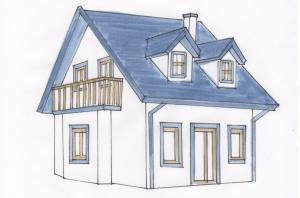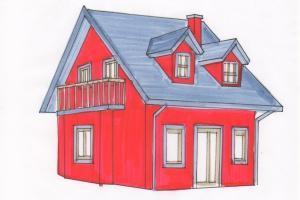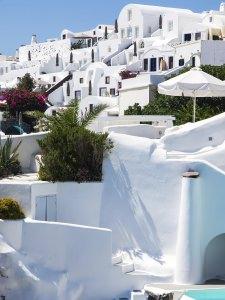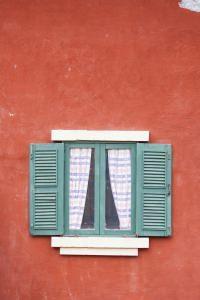How to choose the exterior color of the house
Post from EditorialsThe use of color in the facade should be closely monitored and addressed in relation to the history, style and use of building materials.
Color of the house
 The exterior color of a house is a strong characterization of the building in terms of prestige and, therefore, of identification with the others around: shades used in the outside painting of the house refers both to the socio-cultural conditions of the place, both to the characteristics of the building itself.
The exterior color of a house is a strong characterization of the building in terms of prestige and, therefore, of identification with the others around: shades used in the outside painting of the house refers both to the socio-cultural conditions of the place, both to the characteristics of the building itself. Consider, as an example, as it is much easier to find a fresco or a particular wall decoration, in the mansions of city centers, rather than in the rural houses of rural villages.
Consider, as an example, as it is much easier to find a fresco or a particular wall decoration, in the mansions of city centers, rather than in the rural houses of rural villages.
Coloring an entire house or a single facade is a seemingly easy task. The reality is different from the color swatch provided: a number of factors come into play: the external light, volume, shadows ...

Realistic three-dimensional representations will help the understanding of the final result, but will not be able to give us an impression of what will be the actual outcome.
There are few cases in which the choice of colors has led to wrong solutions strident with the surrounding landscape and, for this reason, in order to safeguard the landscape, the Italian law provides that for the execution of the external wall painting being necessary to submit a specific question to 'Technical Department of the Municipality. 
Many municipalities are now equipped with Colour Plan, which is a document in support of engineers and designers, representing a general framework unit, which provides guidance for the shades and combinations to use if you want to tint your own home.
Choice of color for the outside of the house
 The choice of color and the type of painting should be evaluated going beyond personal taste. The color choice should be made according to the characteristics of the building and the context in which it entered the building itself. For example, the houses of northern Europe are often quite strong colors such as blue, red and brown, while the Mediterranean houses are very light tones, almost always whitish.
The choice of color and the type of painting should be evaluated going beyond personal taste. The color choice should be made according to the characteristics of the building and the context in which it entered the building itself. For example, the houses of northern Europe are often quite strong colors such as blue, red and brown, while the Mediterranean houses are very light tones, almost always whitish.
It is therefore to assess the type of building (shape and volume), its location, and the relationship between the building and the landscape.
In addition, an assessment should be made on the historicity of the building, and an evaluation of chromatic type on all the surfaces that make up the external volume (walls, windows, roofing, gutters and downspouts, window sills, railings or other elements): what color are the fixtures? And the window sills? Would these tints match with the color of the wall that you had suggested? 
To make the right color choice after evaluating a pool of colors according to the recommendations of the Plan of Color, a suggestion is to try to stretch the chosen color, or different colors to choose, on a chipboard surface at least 1 , 00 mx 1.00 m, placing them at the front, in order to evaluate the composition as a whole.
Properties and types of exterior paints
The properties to be considered before buying the right color are waterproofness, breathability and durability. A painting of good quality is able to provide protection, weather resistant, from dirt and pollution. Starting from the principle that each building breathes, in addition to breathability is evaluated positively by the markets' lack of harmful substances to the environment. There are different types of exterior paints can evaluate: quartz paints, paints siloxane, silicate paints, lime-based paints, elastomeric paints and coatings for concrete. Furthermore, there are also colored plaster, of a thickness between 0.5 and 1.5 mm, whose subdivision proposes that the paints (quartz, siloxane, silicate, lime and elastomeric) and the coverings of matter, products that are applied to a wall surface for decorative and protective, having a thickness greater than those obtained in normal paintwork with the use of different paints. Even for the coatings division is made according to the classification already adopted for the paintings (quartz, siloxane, silicate, lime and elastomeric).
There are different types of exterior paints can evaluate: quartz paints, paints siloxane, silicate paints, lime-based paints, elastomeric paints and coatings for concrete. Furthermore, there are also colored plaster, of a thickness between 0.5 and 1.5 mm, whose subdivision proposes that the paints (quartz, siloxane, silicate, lime and elastomeric) and the coverings of matter, products that are applied to a wall surface for decorative and protective, having a thickness greater than those obtained in normal paintwork with the use of different paints. Even for the coatings division is made according to the classification already adopted for the paintings (quartz, siloxane, silicate, lime and elastomeric).
Some tips for painting outside of house
The first thing to do before moving on to painting will be a vigorous brushing to remove the parts in partial detachment, dirt and old paint pliable. In this way, you can also find out what were the previous paintwork and if appropriate, propose them.
79741 REGISTERED USERS










